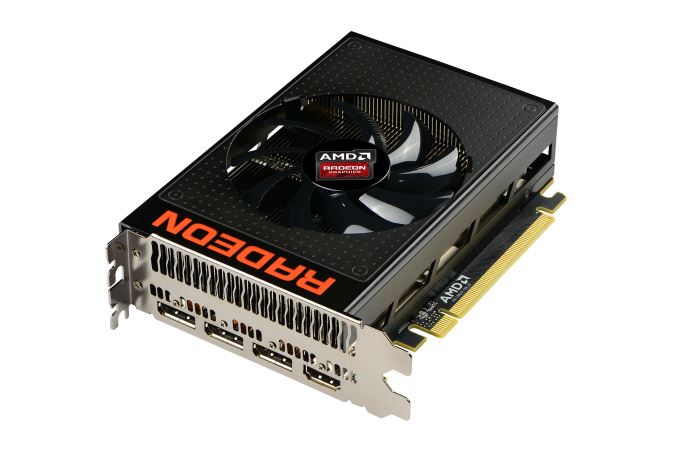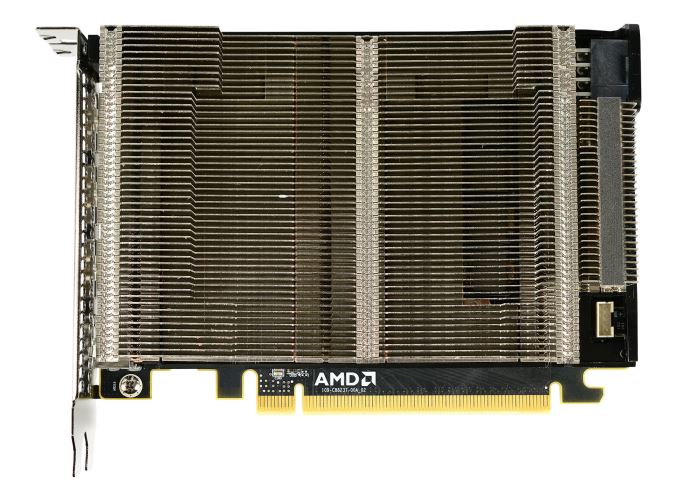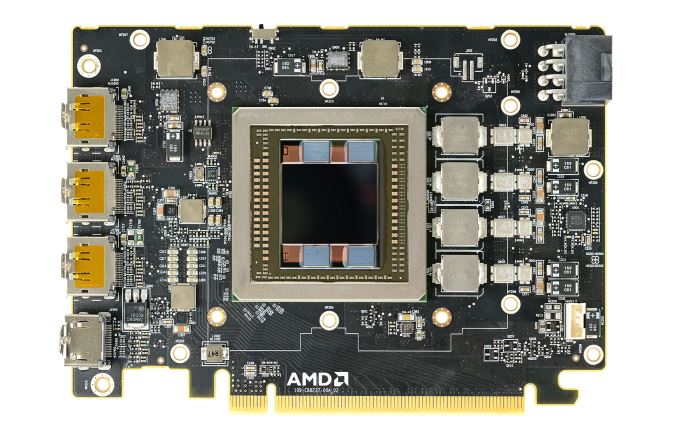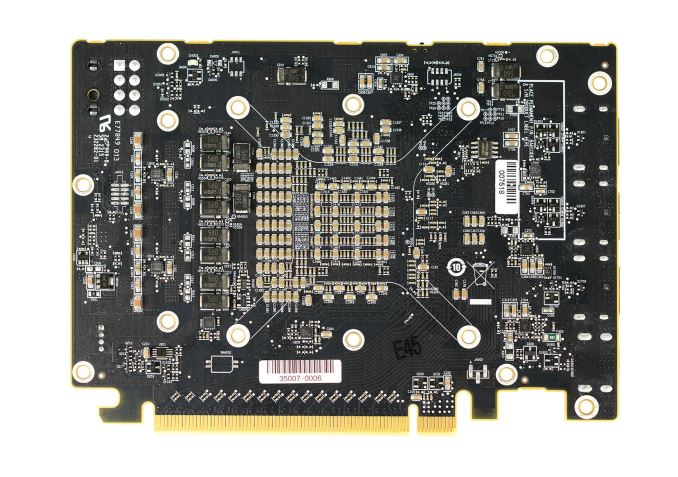The AMD Radeon R9 Nano Review: The Power of Size
by Ryan Smith on September 10, 2015 8:00 AM ESTMeet The Radeon R9 Nano
6 inch video cards are by no means a new thing in the GPU space, however these are traditionally lower-end products that need neither a large cooler nor an extensive power delivery system. As a result the R9 Nano is something of an interesting aberration, packing a lot more power and a lot more technology into half a foot of video card than what we normally see.
Starting as always from the top, the R9 Nano measures 6” long, which is actually a bit shorter than the full length the Mini-ITX standard allows. Responsibility for cooling the card falls to the R9 Nano’s new open air cooler, an aggressive design that has been specifically tailored to allow the card to effectively dissipate 175W of heat in such a small space.
The overall design of the R9 Nano’s cooler is best described as a combination open-air and half-blower hybrid. The design is technically open-air, employing a single axial fan to cool the card. However with only a single fan AMD has been able to align the heatsink fins horizontally and then place the fan in the center of the heatsink. The end result is that roughly half of the heat produced by the card is vented outside of the case, similar to a full blower, while the other half of the heat is vented back into the case. This reduces (though doesn’t eliminate) the amount of hot air being recycled by the card.
The heatsink itself is composed of aluminum and runs virtually the entire length of the card. This is technical a two-piece heatsink, with the primary heatsink composing the bulk of the card, while a much smaller secondary heatsink it found towards the far end of the card and mounted on top of a heatpipe.
Drilling down, we find that the primary heatsink is fed by a combination vapor chamber and heatpipe design. A copper vapor chamber serves to draw heat away from the Fiji GPU and HBM stacks, and then heatpipes are used to better distribute heat to the rest of the heatsink. The use of a vapor chamber in the R9 Nano makes a lot of sense given the fact that vapor chambers are traditionally the most efficient heatsink base type, however the R9 Nano is also unique in that we typically don’t see vapor chambers and heatpipes used together. Other designs such as the high-end GeForce series use a single large vapor chamber across the entire heatsink base, so among reference cards at least the R9 Nano stands alone in this respect. In this case given AMD’s design goals for size and noise, a vapor chamber will play a big part in helping the small card effectively and quietly dissipate 175W.
As for the physical PCB itself, as we can see AMD made it a relatively packed card in order to get the R9 Nano down to 6 inches. Compared to the R9 Fury X reference board, the biggest change here is that AMD has removed a fair bit of power circuitry to save space. By our count there are 4 VRM phases to feed the Fiji GPU, as opposed to the 6 found on R9 Fury X. Power delivery is handled by a single 8-pin PCIe power socket, which is becoming increasingly common, replacing the 2x 6-pin setup for 150W-225W cards.
Meanwhile to further shrink the overall PCB footprint, AMD has moved some of the remaining power delivery circuitry to the back of the card. The front of the card still contains the inductors and heat-sensitive MOSFETs, while a number of capacitors are on the rear of the card (and is why you won’t find a backplate).
Finally, for display I/O R9 Nano is unchanged from R9 Fury X. This means we’re looking at a DVI-free design, with 3x DisplayPort 1.2 and 1x HDMI 1.4 port all along a single row of the I/O bracket. Buyers looking to put together HTPCs will want to be especially mindful of the HDMI 1.4 port; while it's not necessarily a deal-breaker, it does mean that the R9 Nano can't fully drive 4Kp60 TVs, which are slowly but surely becoming more common.
Overall AMD is rather confident in their design for the R9 Nano. The heatsink is built to efficiently dissipate more heat than the 175W the card requires (despite the small size), and as a result we never see the R9 Nano thermally throttle under normal operation. The card’s thermal throttle point is 85C, and in our testing the card never passed 75C, exactly as AMD promised us. What ends up limiting the R9 Nano’s performance then is exactly as expected: the power throttling.
















284 Comments
View All Comments
LoneWolf15 - Thursday, September 10, 2015 - link
And as someone who has been a long time TR reader and has met him multiple times, I am in complete disagreement with you. His testing is some of the most detailed and accurate that I know.I have little faith in your ability to determine someone's subliminal gifts.
Kutark - Thursday, September 10, 2015 - link
Unfortunately a great many people are incapable of projecting their own biases onto someone else. Tomshardware and Anandtech have been accused of being pro one team or the other for years.I remember an article i read a few years back, i wish i could remember the guys name, but he was chief editor for one of the macintosh magazines, and he was talking about how he got so fed up with users because if he said literally anything negative about the product he would get his email inbox blown up with accusations of being a MS nutswinger, and fellating Bill Gates, and various other things. He gave an example of one of the ipods which he gave like a 90%+ review, and the ONLY negative things he said was that the casing was shiny, so it took fingerprints really well and was hard to keep looking clean, and that he wished the battery life was a little bit longer. He said he got the most vitriolic and ridiculous emails he'd ever seen.
The problem is people want confirmation that they made the right choice, and if they don't get that, then rather than admit that they made a mistake, they would rather attack the reviewer as being a fanboy or something equally hideous.
medi03 - Friday, September 11, 2015 - link
In Fermi times Anand found it "appropriate" to compare cherry picked OCed nVidia card vs stock AMD."Subtle bias" my ass.
Ryan Smith - Friday, September 11, 2015 - link
It's something we've apologized for, repeatedly. It was a poor idea and we readily admit as much.http://www.anandtech.com/show/3988/the-use-of-evga...
mapesdhs - Monday, September 14, 2015 - link
I never saw the need to apologise; the price of the FTW meant it was the far better choice to buy back then (I bought two for SLI).fuicharles - Friday, September 11, 2015 - link
I used to go to The Tech Reports to read the Top News contents everyday. Their Top News was always updated and shared lots of recent development.However, recently something fishy, Tech Reports doesn't share any news on the recent Gamesworks and Asyn Compute tragedy in their sites.
And try to pin point the Pump Whine problem even after AMD has already come up new revision of Fury Card which solve the problems.
I don't want to believe Scott Wasson is biased either, but isn't that as a journalist you should share the bad/good for both camp to let the readers judge themselves
milli - Friday, September 11, 2015 - link
'most detailed and accurate' ≠ unbiasedDon't worry that you didn't notice the hidden bias. It took me a while to realize it. After reading TR for a couple years, around 2006 I started noticing the bias. It's not what he says that's biased but what he doesn't say/report that makes him biased. He's smart.
Well he's getting better at hiding his bias these last years. In the previous decade he would often pit OC'd nVidia cards with stock AMD cards in his 'reviews'.
Just like many knew that Anand was biased towards Apple with his ridiculously positive reviews until the final proof came when he went to actually work for them.
slickr - Saturday, September 12, 2015 - link
He has been shilling for Nvidia for good several years now, everything Nvidia does = great, amazing, unique, always winning in some ultra specific aspect even if realistically the card is garbage, when he talks about AMD = power consumption is 10W or 20W more than Nvidia, Nvidia clear winner, price and performance don't matter, only those 10W difference matters.No way for AMD to win, I would have not sent review copies to a whole more websites, there are at least 4-5 of top of my head that are Nvidia shill town and they not even doing it subtly.
althaz - Monday, September 14, 2015 - link
nVidia have had a lead in performance for half a decade or more now - it's not tech reviewers fault that AMD are using more power to deliver worse performance at similar prices.chrnochime - Saturday, September 12, 2015 - link
And we're suppose to have faith in YOUR view of SW? LOL